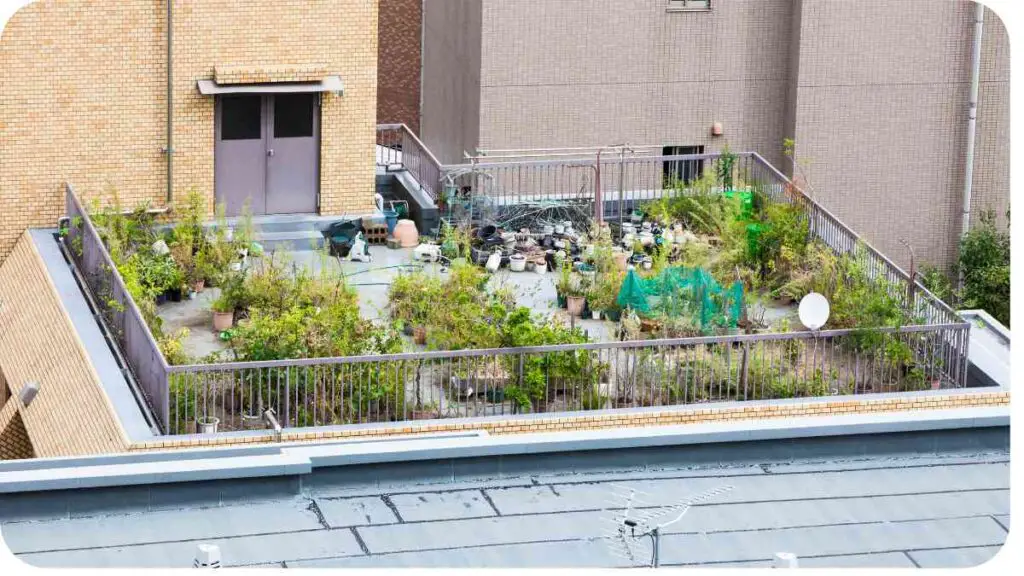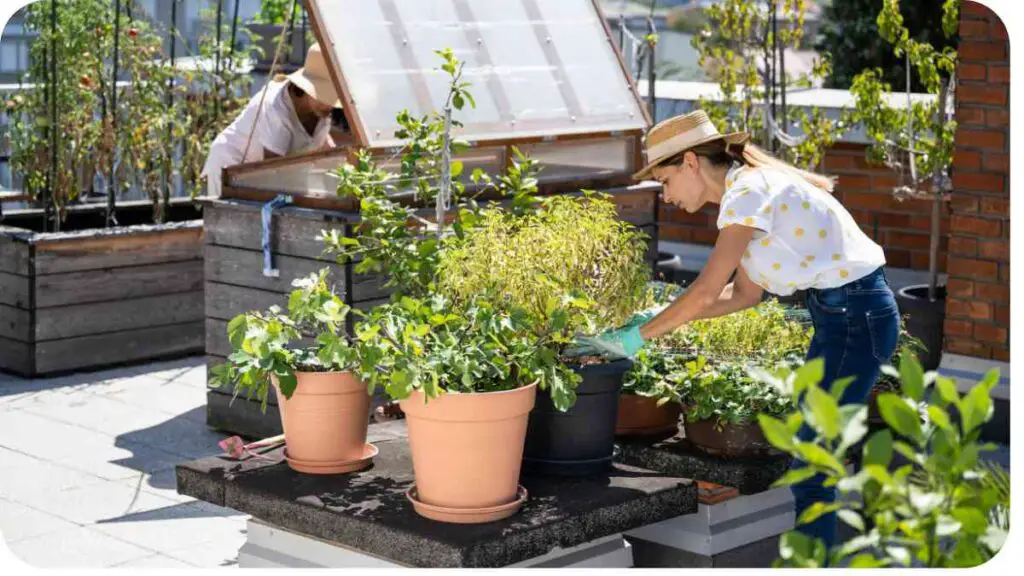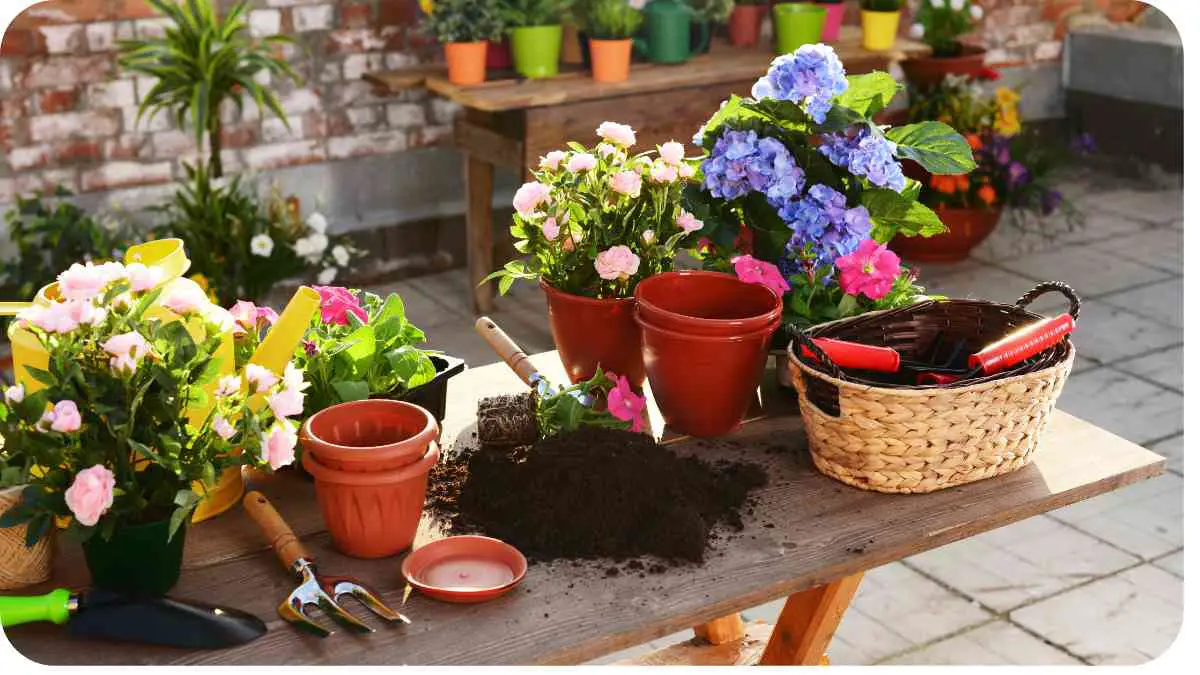Rooftop gardens have gained popularity in urban areas as a sustainable solution for maximizing green spaces. Not only do they provide aesthetic appeal, but they also offer environmental benefits and contribute to healthier communities.
In this article, we’ll explore the process of creating rooftop gardens, from planning and installation to maintenance, along with real-life examples of successful projects.
| Takeaways |
|---|
| 1. Rooftop gardens offer numerous benefits, including environmental conservation, improved air quality, energy efficiency, and enhanced biodiversity. |
| 2. Planning is crucial for the success of rooftop gardens, involving assessments of structural integrity, plant selection, and drainage considerations. |
| 3. Proper installation techniques, such as preparing the roof surface, installing irrigation systems, and selecting suitable containers, are essential for creating a thriving rooftop garden. |
| 4. Regular maintenance tasks, including watering, fertilizing, pest control, and structural inspections, are necessary to ensure the health and longevity of rooftop gardens. |
| 5. Real-life case studies, such as the High Line in New York City and Kensington Roof Gardens in London, provide inspiration and insights into successful rooftop garden projects. |
Benefits of Rooftop Gardens

Before delving into the creation process, let’s highlight some of the key benefits of rooftop gardens. These include:
| Benefit | Description |
|---|---|
| Environmental Conservation | Rooftop gardens help reduce urban heat island effect and mitigate air pollution. |
| Improved Air Quality | Plants absorb carbon dioxide and release oxygen, improving overall air quality. |
| Enhanced Biodiversity | They provide habitats for birds, insects, and other wildlife in urban areas. |
| Energy Efficiency | Green roofs insulate buildings, reducing energy consumption for heating and cooling. |
Planning for a Rooftop Garden

Creating a rooftop garden requires careful planning to ensure its success and longevity. Here are some key considerations:
Assessing Structural Integrity
Before starting any garden project, it’s crucial to assess the structural integrity of the roof. Not all roofs are suitable for supporting the weight of a garden, especially when saturated with water. Consult with a structural engineer to determine if your roof can handle the additional load.
Utilizing compost in a vegetable garden enriches soil, fosters biodiversity, and boosts plant growth. Incorporating compost enhances nutrient availability, water retention, and soil structure, promoting healthier and more productive crops.
| Aspect | Considerations |
|---|---|
| Structural Assessment | Evaluate the load-bearing capacity of the roof and ensure it meets safety standards. |
| Waterproofing | Check for leaks and ensure proper waterproofing to prevent water damage to the building structure. |
| Weight Distribution | Distribute the weight of the garden evenly across the roof to prevent stress on specific areas. |
Choosing the Right Plants
Selecting the appropriate plants is essential for the success of your rooftop garden. Consider factors such as climate, sunlight exposure, and wind conditions. Opt for drought-tolerant plants that can thrive in shallow soil and withstand harsh environmental conditions.
| Aspect | Considerations |
|---|---|
| Climate | Choose plants that are well-suited to your region’s climate and weather patterns. |
| Sunlight Exposure | Assess the amount of sunlight your rooftop receives and select plants accordingly (full sun, partial shade). |
| Wind Resistance | Select plants that can withstand strong winds typical of rooftop environments. |
Considering Drainage Systems
Proper drainage is essential to prevent water buildup and ensure the health of your plants. Install drainage systems such as gutters, downspouts, and drainage mats to channel excess water away from the roof surface. Additionally, incorporate a waterproof membrane to protect the underlying structure from water damage.
Employing organic gardening techniques facilitates soil health improvement through sustainable practices like crop rotation, composting, and natural pest control. Embracing organic methods fosters soil biodiversity, fertility, and resilience, ensuring long-term viability for gardening endeavors.
| Aspect | Considerations |
|---|---|
| Drainage Systems | Install gutters, downspouts, and drainage mats to facilitate water runoff from the roof surface. |
| Waterproofing | Apply a waterproof membrane to prevent water penetration and protect the building structure. |
| Drainage Maintenance | Regularly inspect and clean drainage systems to prevent clogs and ensure proper water flow. |
By carefully planning and addressing these considerations, you can create a rooftop garden that thrives while minimizing potential risks and challenges.
Installation Process
Once you’ve completed the planning phase, it’s time to move on to the installation process. Here’s a step-by-step guide to creating your rooftop garden:
Preparing the Roof Surface
Before installing any vegetation, ensure the roof surface is adequately prepared. This involves cleaning the area, repairing any damage, and applying a protective membrane to prevent water leakage.
| Step | Description |
|---|---|
| Clean the Roof Surface | Remove debris, dirt, and any existing vegetation from the roof to create a clean planting surface. |
| Repair Any Damage | Fix any cracks, leaks, or structural issues on the roof surface to ensure its integrity. |
| Apply Waterproof Membrane | Install a waterproof membrane to protect the roof from water infiltration and damage. |
Installing Irrigation Systems
Proper irrigation is crucial for maintaining the health and vitality of your rooftop garden. Depending on the size and layout of your garden, you may opt for drip irrigation systems or manual watering methods.
| Step | Description |
|---|---|
| Choose Irrigation System | Select an irrigation system that meets the needs of your rooftop garden, considering water efficiency and ease of maintenance. |
| Install Drip Lines | Lay out drip lines or irrigation hoses to deliver water directly to the plant roots, minimizing waste and evaporation. |
| Set Timer or Schedule | Program an irrigation timer or schedule regular watering sessions to ensure consistent moisture levels for your plants. |
Selecting Suitable Containers
Container gardening is a popular choice for rooftop gardens, as it allows for flexibility and mobility. Choose containers that are lightweight, durable, and provide adequate drainage for plant roots.
Raised beds offer numerous benefits for gardeners, including improved drainage, soil aeration, and weed control. Elevating plants in raised beds promotes easier access for maintenance, optimizes space utilization, and extends the growing season, resulting in healthier and more abundant harvests
| Step | Description |
|---|---|
| Choose Containers | Select containers made from materials such as plastic, fiberglass, or lightweight ceramics that are suitable for rooftop environments. |
| Ensure Drainage Holes | Check that containers have drainage holes to prevent waterlogging and root rot in your plants. |
| Arrange Containers | Arrange containers strategically to optimize space and sunlight exposure for your rooftop garden. |
By following these steps, you can effectively install a rooftop garden that enhances your living or working space while promoting environmental sustainability and green living.
Maintenance Tips
Once your rooftop garden is installed, regular maintenance is essential to ensure its health and longevity. Here are some key maintenance tips to keep your garden thriving:
Botanical gardens employ meticulous measures to prevent the spread of plants, ensuring ecological preservation and public safety. Through rigorous protocols, botanical gardens maintain plant collections while safeguarding native habitats and preventing invasive species proliferation, contributing to biodiversity conservation efforts worldwide.
Watering and Fertilizing
Proper watering and fertilization are crucial for the growth and development of your rooftop plants. Monitor soil moisture levels regularly and adjust watering frequency based on weather conditions and plant needs.
| Aspect | Tips |
|---|---|
| Watering | Water plants deeply, ensuring the soil is thoroughly moistened but not waterlogged. |
| Fertilizing | Apply a balanced fertilizer periodically to replenish nutrients and promote healthy plant growth. |
| Mulching | Mulch the soil surface to retain moisture, suppress weeds, and regulate soil temperature. |
Pest Control
Pests and diseases can pose a threat to your rooftop garden, especially in urban environments. Implement pest control measures such as regular inspections, natural predators, and organic pesticides to prevent infestations.
| Aspect | Tips |
|---|---|
| Inspections | Regularly inspect plants for signs of pests or diseases, such as holes in leaves or discoloration. |
| Beneficial Insects | Encourage beneficial insects such as ladybugs and lacewings to control pest populations naturally. |
| Organic Pest Control | Use organic pest control methods such as neem oil, insecticidal soap, or diatomaceous earth. |
Regular Inspections
Performing routine inspections is essential for identifying and addressing any issues before they escalate. Check for signs of plant stress, nutrient deficiencies, or structural damage to ensure the health and safety of your rooftop garden.
| Aspect | Tips |
|---|---|
| Plant Health | Monitor plant growth and appearance regularly, looking for signs of stress, wilting, or discoloration. |
| Structural Integrity | Inspect the roof surface and containers for signs of damage or wear, such as cracks or leaks. |
| Safety Checks | Ensure that railings, walkways, and access points are secure and comply with safety regulations. |
By following these maintenance tips, you can enjoy a thriving rooftop garden that enhances your living or working space while promoting environmental sustainability and green living. Regular care and attention will ensure that your garden continues to flourish and provide enjoyment for years to come.
Maintenance Tips
Once your rooftop garden is installed, it’s essential to provide regular care and maintenance to ensure its health and longevity. Here are some maintenance tips to keep your garden thriving:
Hydroponic vegetables undergo controlled cultivation in nutrient-rich water solutions, yielding safe and nutritious produce. Understanding the safety of hydroponic vegetables involves assessing cultivation practices, nutrient management, and potential risks, ensuring consumer confidence in this innovative farming method.
Watering and Fertilizing
Proper watering and fertilization are key to the success of your rooftop garden. Monitor soil moisture levels regularly and adjust watering frequency based on weather conditions and plant needs. Additionally, provide nutrients to your plants through organic or synthetic fertilizers as needed.
| Tip | Description |
|---|---|
| Monitor Soil Moisture Levels | Use a moisture meter or visually inspect the soil to determine when watering is necessary. |
| Water Early in the Morning | Water your plants early in the morning to minimize evaporation and ensure efficient water uptake. |
| Fertilize According to Plant Needs | Apply fertilizer according to the specific requirements of your plants and the growing season. |
| Use Organic Mulch | Mulch helps retain moisture in the soil, suppresses weed growth, and adds nutrients as it decomposes. |
Pest Control
Pests can pose a threat to your rooftop garden, so it’s essential to implement pest control measures to protect your plants. Regularly inspect your garden for signs of pest infestation and take appropriate action to mitigate damage.
| Tip | Description |
|---|---|
| Inspect Plants for Pests | Regularly check your plants for signs of pest infestation, such as chewed leaves or insect damage. |
| Use Natural Predators | Introduce beneficial insects or birds that feed on garden pests as a natural pest control method. |
| Apply Organic Pest Control Solutions | Use organic pesticides or homemade remedies such as neem oil or insecticidal soap to deter pests. |
| Practice Crop Rotation | Rotate plantings to prevent the buildup of pests and diseases in the soil over time. |
Regular Inspections
Regular inspections are essential to identify and address any issues before they escalate. Take the time to inspect your rooftop garden thoroughly, paying attention to plant health, drainage systems, and structural integrity.
| Tip | Description |
|---|---|
| Check for Signs of Disease | Look for symptoms of plant diseases, such as yellowing leaves, wilting, or unusual growth patterns. |
| Inspect Drainage Systems | Ensure gutters, downspouts, and drainage mats are clear of debris and functioning properly. |
| Assess Structural Integrity | Periodically assess the structural integrity of the roof and containers to detect any signs of damage. |
By following these maintenance tips and staying proactive in caring for your rooftop garden, you can ensure its continued health and beauty for years to come. Remember to stay attentive to your plants’ needs and address any issues promptly to prevent problems from escalating.
Case Studies: Successful Rooftop Gardens

To gain a better understanding of the real-world application of rooftop gardens, let’s explore some case studies of successful projects:
1. The High Line, New York City
The High Line is a renowned example of urban revitalization through rooftop gardening. This elevated park was built on a historic freight rail line elevated above the streets on Manhattan’s West Side. Designed by landscape architects James Corner Field Operations and Diller Scofidio + Renfro, the High Line features a diverse range of plantings, including perennials, grasses, shrubs, and trees.
| Key Features | Description |
|---|---|
| Adaptive Reuse | The High Line transformed an abandoned railway into a vibrant public space, attracting millions of visitors annually. |
| Biodiversity | The park’s diverse plantings support local ecosystems and provide habitats for birds, insects, and other wildlife. |
| Sustainability | The High Line incorporates sustainable design elements such as green roofs, permeable paving, and rainwater harvesting. |
| Community Engagement | The park serves as a gathering place for residents and visitors, hosting cultural events, art installations, and educational programs. |
2. Chicago City Hall Rooftop Garden
Chicago City Hall is home to one of the most notable examples of a green roof in the United States. The rooftop garden spans 20,300 square feet and features over 150 species of plants, including native grasses, perennials, and sedums. Designed by landscape architect Terry Guen, the garden serves as a model for sustainable urban development and green infrastructure.
| Key Features | Description |
|---|---|
| Stormwater Management | The rooftop garden helps mitigate stormwater runoff, reducing strain on the city’s sewer system and alleviating flooding. |
| Energy Efficiency | Green roofs insulate the building, reducing energy consumption for heating and cooling and extending the lifespan of the roof. |
| Educational Outreach | The garden serves as an educational resource, offering tours, workshops, and seminars on green roof technology and sustainability. |
| Urban Heat Island Mitigation | By absorbing heat and reducing ambient temperatures, green roofs help mitigate the urban heat island effect in densely populated areas. |
3. Kensington Roof Gardens, London
Kensington Roof Gardens is a unique rooftop oasis situated atop a former department store in London. Designed by landscape architect Ralph Hancock in the 1930s, the gardens span 1.5 acres and feature themed areas, including Spanish, Tudor, and English woodland gardens. The gardens are open to the public and host events, weddings, and corporate functions.
| Key Features | Description |
|---|---|
| Historic Preservation | The gardens are listed as a Grade II* heritage site and are renowned for their historical significance and architectural beauty. |
| Cultural Landmark | Kensington Roof Gardens attract visitors from around the world, offering a tranquil escape from the bustling city below. |
| Ecological Diversity | The gardens support a diverse range of plant and animal species, including rare and exotic plants, birds, and insects. |
| Social Hub | The gardens serve as a social hub, hosting events, live music performances, and charity fundraisers throughout the year. |
These case studies demonstrate the diverse applications and benefits of rooftop gardens in urban environments. From ecological conservation and stormwater management to cultural enrichment and community engagement, rooftop gardens play a vital role in creating sustainable, livable cities for future generations.
Case Studies: Successful Rooftop Gardens
Real-life examples of successful rooftop gardens can provide valuable insights and inspiration for your own project. Let’s explore a few case studies:
1. The High Line, New York City
The High Line is a renowned elevated linear park built on a historic freight rail line in Manhattan. This innovative project transformed an abandoned railway into a vibrant green space, featuring a diverse array of plants, trees, and public amenities.
| Aspect | Description |
|---|---|
| Location | Located on Manhattan’s West Side, the High Line spans 1.45 miles from Gansevoort Street to 34th Street. |
| Design | Designed by landscape architecture firm James Corner Field Operations, the High Line incorporates native plantings and urban design elements. |
| Environmental Impact | The High Line has revitalized a disused industrial space, providing habitat for wildlife and reducing stormwater runoff in the urban environment. |
| Community Engagement | The park offers cultural programming, art installations, and educational events, fostering community engagement and social interaction. |
2. Chicago City Hall Rooftop Garden
Chicago City Hall is home to one of the most extensive rooftop gardens in the city. This green oasis atop a government building showcases the potential for integrating green spaces into urban infrastructure.
| Aspect | Description |
|---|---|
| Sustainability | The rooftop garden helps mitigate the urban heat island effect, reduce energy consumption, and improve air quality in downtown Chicago. |
| Food Production | The garden includes vegetable beds and fruit trees, providing fresh produce for the building’s cafeteria and local food banks. |
| Educational Outreach | Chicago City Hall offers guided tours of its rooftop garden, educating visitors about sustainable gardening practices and urban agriculture. |
| Partnerships | The garden is maintained through partnerships with local organizations, businesses, and community volunteers, fostering collaboration and stewardship. |
3. Kensington Roof Gardens, London
Kensington Roof Gardens is a stunning rooftop oasis located in the heart of London. Spread across 1.5 acres, it features themed gardens, water features, and even flamingos, offering a tranquil escape from the bustling city below.
| Aspect | Description |
|---|---|
| Design Inspiration | Designed in the 1930s, the gardens draw inspiration from various historical and cultural themes, including Spanish, English, and Moorish influences. |
| Biodiversity | The gardens are home to a diverse range of plant species, attracting pollinators such as bees and butterflies, contributing to urban biodiversity. |
| Events and Hospitality | Kensington Roof Gardens host private events, weddings, and corporate functions, generating revenue while providing a unique venue for special occasions. |
| Conservation Efforts | The gardens participate in conservation initiatives and wildlife protection programs, contributing to habitat preservation and ecological awareness. |
These case studies demonstrate the diverse range of rooftop garden projects around the world, each with its unique design, purpose, and impact on the surrounding environment and community. Whether revitalizing urban spaces, promoting sustainability, or providing recreational amenities, rooftop gardens play a vital role in creating greener, healthier cities for generations to come.
Conclusion
Rooftop gardens offer a myriad of benefits, from environmental sustainability to community engagement and aesthetic enhancement. Through careful planning, installation, and maintenance, these green spaces can transform unused rooftop areas into vibrant ecosystems that contribute to a healthier, more sustainable urban environment.
By assessing structural integrity, choosing suitable plants, and implementing effective drainage systems, individuals and organizations can create rooftop gardens that thrive in diverse climatic conditions. Regular maintenance, including watering, fertilizing, pest control, and structural inspections, is essential for ensuring the long-term health and vitality of rooftop gardens.
Drawing inspiration from successful case studies such as the High Line in New York City, Chicago City Hall Rooftop Garden, and Kensington Roof Gardens in London, individuals and communities can explore innovative design ideas and strategies for creating their own rooftop oasis.
Whether you’re a homeowner looking to maximize outdoor space, a business seeking to enhance corporate social responsibility, or a city planner aiming to improve urban livability, rooftop gardens offer endless possibilities for sustainability, biodiversity, and community well-being.
In conclusion, rooftop gardens represent a green revolution in urban design, offering a holistic solution to the challenges of modern urbanization. By harnessing the power of nature and embracing innovative green technologies, we can create healthier, more resilient cities for future generations to enjoy.
Further Reading
Here are some additional resources to explore for more information on rooftop gardening:
- MasterClass: Rooftop Garden Guide
- Learn expert tips and techniques for creating and maintaining a thriving rooftop garden.
- HGTV: Grow a Rooftop Garden
- Discover inspiration and ideas for designing and growing your own rooftop garden with HGTV’s comprehensive guide.
- Gardening Know How: Creating Your Own Rooftop Garden
- Find practical advice and step-by-step instructions for creating a successful rooftop garden in this informative article.
FAQs
How do I start planning my rooftop garden?
To begin planning your rooftop garden, assess the structural integrity of your roof, choose suitable plants based on sunlight exposure and climate, and consider installing drainage systems to ensure proper water management.
What are the benefits of rooftop gardening?
Rooftop gardening offers numerous benefits, including environmental conservation, improved air quality, energy efficiency, and enhanced biodiversity in urban areas.
What type of plants are suitable for rooftop gardens?
Drought-tolerant plants, succulents, and native species are ideal choices for rooftop gardens, as they can thrive in shallow soil and withstand harsh environmental conditions.
How do I maintain my rooftop garden?
Regular maintenance tasks include watering, fertilizing, pest control, and structural inspections. It’s essential to monitor soil moisture levels, provide nutrients to your plants, and address any issues promptly to ensure the health and vitality of your garden.
Are there any challenges associated with rooftop gardening?
Some challenges of rooftop gardening include structural limitations, limited space, and exposure to harsh weather conditions such as wind, heat, and cold. However, with proper planning and maintenance, these challenges can be overcome to create a successful rooftop garden.

For 15 years, Hellen James has worked in the gardening industry as an expert and landscape designer. During her career, she has worked for a variety of businesses that specialize in landscaping and gardening from small firms to large corporations.

